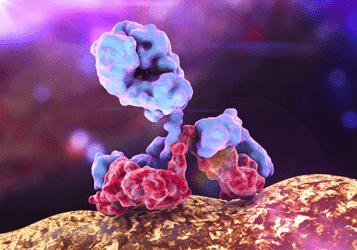- Home
- Products
- Anti-Ab ADCs
- IgG Fc
- anti-MIgG(Fc)Fab-N-DM1 ADC
anti-MIgG(Fc)Fab-N-DM1 ADC (CAT#: ADC-AA-031)
This ADC product is comprised of a Fab fragment of an anti-mouse IgG Fc specific polyclonal antibody conjugated via a noncleavable linker to DM1. The antibody portion is a Fab fragment of a secondary antibody and the drug portion, DM1, is a cytotoxic small molecule which binds to tubulins, interrupts microtubule dynamics, and induces cell death. This product displays no obvious toxicity without a primary antibody and can be a quite efficient and economical alternative to pre-screening mouse monoclonal antibodies as ADC candidates.
- ADC Target
- ADC Antibody
- ADC Linker
- ADC payload drug
- Name
- IgG Fc
- Overview
- The fragment crystallizable region (Fc region) is composed of the constant region of the two heavy chains that form the IgG molecule. The Fc region of IgG bears a highly conserved N-glycosylation site. Glycosylation of the Fc fragment is essential for Fc receptor-mediated activity. Fc binds to various cell receptors and complement proteins thus mediating different physiological effects of antibodies, such as opsonization, antibody dependent cellular cytotoxicity (ADCC), degranulation of mast cells, basophils, eosinophils and other processes.
- Overview
- Fab fragment of anti-mouse IgG Fc specific polyclonal antibody
- Species Reactivity
- Mouse
- Name
- Noncleavable linkers
- Description
- Noncleavable linkers, is considered noncleavable-meaning linker cleavage, and payload release does not depend on the differential properties between the plasma and some cytoplasmic compartments. Instead, the release of the cytotoxic drug is postulated to occur after internalization of the ADC via antigen-mediated endocytosis and delivery to lysosomal compartment, where the antibody is degraded to the level of amino acids through intracellular proteolytic degradation.
- Name
- DM1 (N2’-Deacetyl-N2’-(3-mercapto-1-oxopropyl)maytansine)
- Description
- Derived from Maytansinoid,a group of cytotoxins structurally similar to rifamycin, geldanamycin, and ansatrienin. The eponymous natural cytotoxic agent maytansine is a 19-member lactam (ansa
macrolide) structure originally isolated from the Ethiopian shrub Maytenus ovatus. Maytansinoids can bind to tubulin at or near the vinblastine-binding site, which interfere the formation of microtubules and depolymerize already formed microtubules, inducing mitotic arrest in the intoxicated cells.
For Research Use Only. NOT FOR CLINICAL USE.
Related Products
- anti-MIgG(Fc)-C-DMSA ADC (CAT#: ADC-AA-023)
- anti-Rat IgG(Fc)-N-MMAF ADC (CAT#: ADC-AA-039)
- anti-HIgG(Fc)Fab-C-DMDM ADC (CAT#: ADC-AA-013)
- anti-Rat IgG(Fc)Fab-C-MMAF ADC (CAT#: ADC-AA-042)
- Protein G-Amanitin ADC (CAT#: WJY-0423-LS108)
- anti-RIgG(HL)-C-MMAE ADC (CAT#: ADC-AA-036)
- Protein A-MCC-DM1 ADC (CAT#: ADC-AA-054)
- Anti-HIgG(Fc)-C-DX8951 ADC (CAT#: ADC-AA-060)
- anti-MIgG(Fc)-C-MMAF ADC (CAT#: ADC-AA-020)
- anti-Rat IgG(HL)Fab-N-MMAF ADC (CAT#: ADC-AA-046)
Published Data
+ Submit Publications

Scientific Resources
Customer Reviews and FAQs
There are currently no Customer reviews or questions for ADC-AA-031. Click the button above to contact us or submit your feedback about this product.
Customer Reviews
FAQ

Excellent
The anti-MIgG(Fc)Fab-N-DM1 ADC has been a game changer in our antibody development, offering powerful tubulin interaction without compromising safety.

Excellent
The safety profile and efficacy of the anti-MIgG(Fc)Fab-N-DM1 ADC make it an indispensable tool for early-stage antibody development.

Excellent
The specificity and stability of the anti-MIgG(Fc)Fab-N-DM1 ADC have tremendously improved our selection process for potent monoclonal antibodies.

Excellent
We rely heavily on the anti-MIgG(Fc)Fab-N-DM1 ADC for its precise action on microtubules, which is crucial for our cytotoxicity studies. It's a top-tier research tool.

Excellent
The non-toxic nature of this ADC without a primary antibody is a major advantage, allowing for safe and efficient pre-screening of various antibodies.
Quick Links
Other Products
Same Target
Same Linker
Same Payload
| CAT# | Product Name | Linker | Payload |
| ADC-AA-051 | Protein G-Duocarmycin ADC | Duocarmycins | |
| ADC-AA-052 | Protein A-VC-MMAE ADC | VC (valine-citrulline) | MMAE (Monomethyl auristatin E) |
| ADC-AA-056 | Anti-MIgG-VC-MMAE ADC | VC (valine-citrulline) | MMAE (Monomethyl auristatin E) |
| ADC-AA-020 | anti-MIgG(Fc)-C-MMAF ADC | Cleavable linkers | MMAF (Monomethyl auristatin F) |
| ADC-AA-053 | Protein A-MMAF ADC | MMAF (Monomethyl auristatin F) |
| CAT# | Product Name | Linker | Payload |
| ADC-AA-018 | anti-HIgG(Fab)-N-DM1 ADC | Noncleavable linkers | DM1 (N2’-Deacetyl-N2’-(3-mercapto-1-oxopropyl)maytansine) |
| ADC-AA-008 | anti-HIgG(Fc)-N-DM1 ADC | Noncleavable linkers | DM1 (N2’-Deacetyl-N2’-(3-mercapto-1-oxopropyl)maytansine) |
| ADC-AA-046 | anti-Rat IgG(HL)Fab-N-MMAF ADC | Noncleavable linkers | MMAF (Monomethyl auristatin F) |
| ADC-AA-037 | anti-RIgG(HL)Fab-N-MMAF ADC | Noncleavable linkers | MMAF (Monomethyl auristatin F) |
| ADC-AA-015 | anti-HIgG(Fc)Fab-N-DM1 ADC | Noncleavable linkers | DM1 (N2’-Deacetyl-N2’-(3-mercapto-1-oxopropyl)maytansine) |
| CAT# | Product Name | Linker | Payload |
| ADC-W-495 | Anti-EGFR-SMCC-DM1 ADC-4 | SMCC (N-succinimidyl 4-(Nmaleimidomethyl)cyclohexane-1-carboxylate) | DM1 (N2’-Deacetyl-N2’-(3-mercapto-1-oxopropyl)maytansine) |
| ADC-AA-050 | Protein G-MCC-DM1 ADC | MCC (Maleimidomethyl cyclohexane-1-carboxylate) | DM1 (N2’-Deacetyl-N2’-(3-mercapto-1-oxopropyl)maytansine) |
| ADC-W-603 | Anti-FOLH1-SMCC-DM1 ADC-3 | SMCC (N-succinimidyl 4-(Nmaleimidomethyl)cyclohexane-1-carboxylate) | DM1 (N2’-Deacetyl-N2’-(3-mercapto-1-oxopropyl)maytansine) |
| ADC-AA-026 | anti-MIgG(Fc)-N-DM1 ADC | Noncleavable linkers | DM1 (N2’-Deacetyl-N2’-(3-mercapto-1-oxopropyl)maytansine) |
| ADC-AA-015 | anti-HIgG(Fc)Fab-N-DM1 ADC | Noncleavable linkers | DM1 (N2’-Deacetyl-N2’-(3-mercapto-1-oxopropyl)maytansine) |
Online Inquiry
Welcome! For price inquiries, please feel free to contact us through the form on the left side. We will get back to you as soon as possible.



